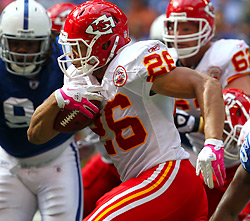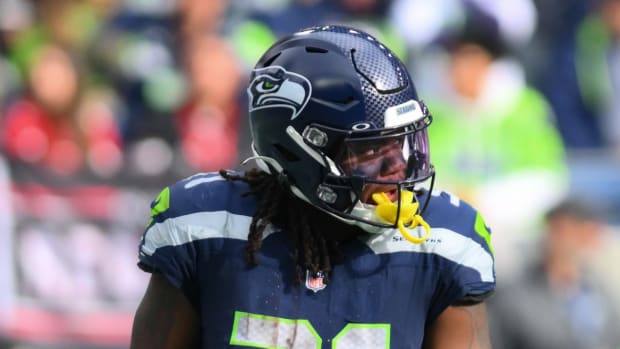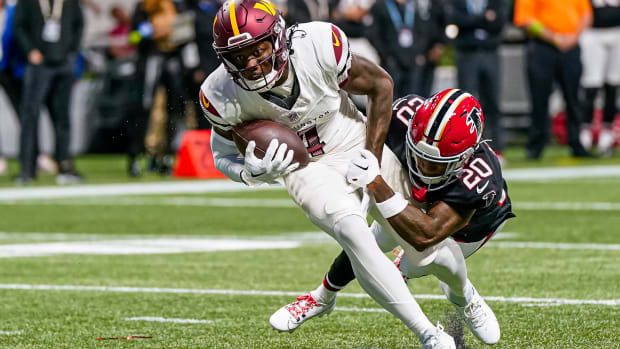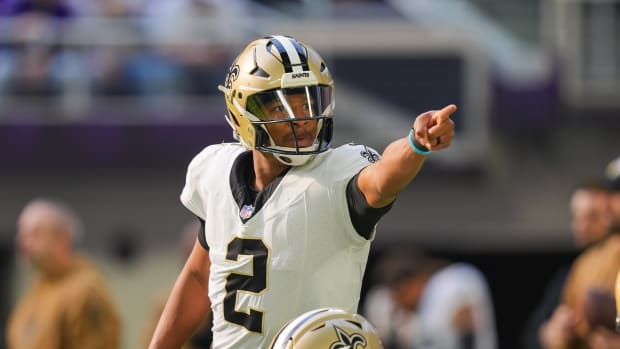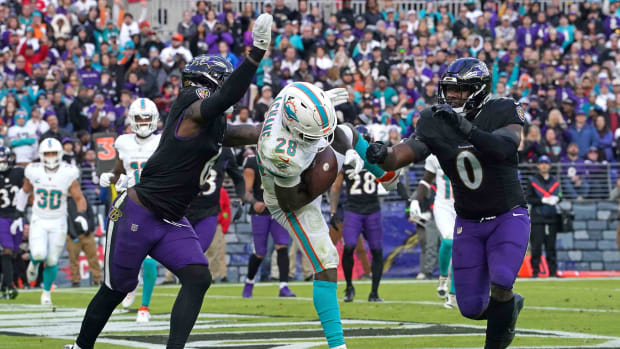Break It Down: Chiefs find their groove
The emergence of Jackie Battle in Week 5 allowed the Chiefs offense to fully get on track. (Michael Hickey/US Presswire)
In Break It Down, I will go back and analyze the Xs and Os of a notable play or performance from Sunday’s games.
The Chiefs' back-to-back wins have come against Minnesota and Indianapolis, a combined 1-9, so it's important to keep any excitement over Kansas City's sudden rise in perspective. Still, the Chiefs look like a different, more confident team these past two weeks -- especially on offense.
It started with a tiff between QB Matt Cassel and head coach Todd Haley on the sideline in Week 4. Since then, Cassel's been playing more like the quarterback who helped the Chiefs to a surprising division title last year.
He's not doing it alone, of course. The biggest key to Kansas City's come-from-behind win in Indianapolis Sunday was the emergence of Jackie Battle at running back.
Battle came into Sunday with 155 career rushing yards; he had 119 Sunday. As a result K.C. struck a run-pass balance that left the Colts reeling. Let's take a look:
This is the last play of the first quarter, a 3rd-and-9 for the Chiefs from near midfield. It's an obvious passing down. The Colts rush four and drop seven, while the Chiefs leave six in to block and send four receivers out.
You can see two of Cassel's option are already blanketed, and the Colts still have four downfield defenders to deal with the other two. Cassel wound up taking a sack on this play and the Chiefs punted.
There's no reason for the Colts to fear the run on 3rd-and-9. And the catch-22 for the Chiefs is that they were in 3rd-and-9 because the run game generated one yard on two carries before that. So, Indianapolis could just sit and wait for the pass in obvious passing downs.
Contrast that to this:
Three possessions later, already down 17-0, the Chiefs inserted Battle at running back and finally put a drive together. The picture just above is a 1st-and-10 from Indy's 41. The Colts are in their 4-3 look and have walked a defensive back up near the line to give them eight defenders in a five-yard window.
That leaves one-on-one coverage outside with one safety deep. This is a defensive look that's designed to stop the run.
Instead, Cassel throws.
His No. 1 target, Dwayne Bowe, runs a simple quick slant route, gets inside of Jacob Lacey for an easy catch and then has just one defender to beat. He does so and scores.
This is a prototypical example of the run setting up the pass. Kansas City ran on the first four plays of this possession for 19 yards -- not great numbers, but enough to keep the Chiefs in manageable down-and-distance situations.
The enhanced run threat from Battle allowed the Chiefs to start using their short routes with the Colts stacking the box.
On the play before Cassel's TD strike to Bowe, the Chiefs faced a 3rd-and-3. Even though K.C. lined up in the shotgun, the Colts still pressed nine defenders within four yards of the line of scrimmage:
Dexter McCluster, lined up on Cassel's left, flared out toward the sideline and was wide open for 10 yards.
And, slowly but surely, as the run game continued to roll and Cassel found his confidence, the Chiefs opened the playbook and took some shots downfield. Why is this important? Well, the Chiefs offense has been at its best when Cassel has stretched the defense.
In a Week 1 loss to Buffalo, Cassel averaged a paltry 3.3 yards per pass attempt. That number was just 6.0 in a Week 2 loss to Detroit. Contrast that to 9.0 yards per attempt in the Chiefs' win over Minnesota, and 8.9 YPA Sunday.
The short passes and successful runs gave Cassel room to hit plays like this one, deep and up the sideline to Bowe, between two Colts defenders:
Again, this is the balance we're talking about. Running for 100 yards and completing some 10-yard dump-offs will only get you so far. But the Chiefs managed to work the total offense into the rally Sunday.
Bowe found some room downfield, which helped the runs/underneath routes work, and vice versa.
Eventually, the Colts had no idea what to prepare for.
The Chiefs were still down 24-14 in the third quarter, when they took over on their own 7-yard line. On 1st-and-10, the Colts showed blitz, then came with six defenders against a Chiefs' run formation.
Instead, Cassel swung it to Bowe on another slant route for 12 yards.
Kansas City followed that up with a 12-yard Battle run and a 21-yard Thomas Jones run. The drive ended with a Cassel-to-Bowe TD pass.
The Chiefs completed their comeback and took the lead with 5:15 left. Facing a 3rd-and-2 on the Indianapolis 11, they came out in an offset I-formation with just two receivers -- Bowe up top right and Steve Breaston at the bottom of this photo:
The Colts are actually in a nickel defense there, with five defensive backs. The problems for them, though, are two-fold: 1. They still have eight defenders in the box, looking run first; 2. Breaston is one-on-one with rookie corner Chris Rucker, who had just replaced an injured Jerraud Powers for this snap.
And making Rucker's challenge harder is that the deep safety has to be concerned with Bowe, who's also one-on-one and has burned the Colts, as we've seen, on the slant all day.
With the Colts jamming the middle of the field, Cassel simply floats one wide to Breaston and he makes the TD grab.
Sometimes, people get too caught up in looking at the run/pass breakdown. Not every team needs a relatively even split to be successful. The Patriots, for example, can throw on just about every down. The same can be said, this year, for the Lions, who have barely gotten anything out of their ground game.
But the Chiefs need the full arsenal. Kansas City has deep threats in Bowe and Breaston, but some of the Chiefs' best work comes on rapid-fire strikes -- those slants, McCluster out of the backfield or screen passes.
































